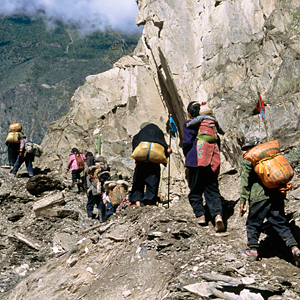Are there superhumans living among us? New research adds Tibetans to the list of humans who have evolved in the modern era.

You’re hiking in the Himalayas, one of tallest mountain ranges in the world, and you are struggling. You’re miles above sea-level, your head is in a fog—both the literal one and the disorienting sensation—and it is getting hard to breathe. Altitude sickness is setting in, and you are starting to wish that you had spent more time acclimating to the thin air. As your body fights every step, the Tibetan guide ahead has a smoke, waiting for you to catch up.
But you shouldn’t feel too inadequate. Thousands of years of natural selection have given Tibetans an advantage—they have evolved to cope with their extreme environment.
With an average elevation of 13,000 feet above sea level, Tibet has some of the thinnest air on the planet, with 40 percent less oxygen than is found at sea level. When foreigners travel there, after suffering through mountain sickness, their bodies adapt by producing more of the oxygen-carrying pigment hemoglobin, and when they return to sea level they can make more of every breath. But if a lowlander stays in this high-altitude environment for too long, the adaptation starts to turn against his or her health. Elevated hemoglobin levels thicken the blood, and the heart struggles to pump it around the body. This can cause swelling of the heart and lungs and a loss of fertility. However, indigenous Tibetans have none of these problems.
Recent research shows that Tibetans, who have lived isolated in these high altitudes for thousands of years, enjoy a genetic variation that keeps their hemoglobin levels in a normal range. A variation of EPAS1, a gene that is sometimes associated with increased athleticism, causes an enzymatic change in the way oxygen binds to blood and is transported around the body. Compared to lowland Chinese, Tibetans thrive in high altitude—they do not suffer from chronic altitude sickness and their children are born with normal weight.
“It makes them super athletes at altitude, without a doubt,” says Ken Kamler, a surgeon, author of Surviving the Extremes and an editorial advisor to Popular Mechanics. “I’ve been on climbs with these guys, and I’m maybe a foot taller than some of them, and they carry loads on their backs that I can’t even lift off the ground, and they will carry them way faster than I’m climbing with a much lighter load.”
Even with rigorous training, a person from sea level will almost always lag behind the Sherpas at altitude, Kamler says. “They climb steadily and rapidly to the point where they are getting, and then they wait,” he says. “These guys are obviously different from us.”
The EPAS1 found in Tibetans is the fastest example of human adaptation ever recorded—in 3000 years, the frequency of the gene grew from 10 percent to 90 percent in Tibetans, says Rasmus Nielsen, an evolutionary biologist at University of California–Berkeley. To put that time frame in perspective, lactose tolerance in humans, a trait that about 80 percent of Europeans have, developed over a 7500-year period. “The interesting thing to think about is that a lot of people would have had to die in that period for the allele frequency to change like that,” Nielsen says—making it one of the clearest examples of natural selection in humans.
In the future, the benefits of these “fit” genes might be extended to the general population through gene therapy—the use of pharmaceuticals to change the DNA structure of a living person. Any patients whose oxygen transport has been compromised—diabetics and sufferers of heart and lung diseases—would be the beneficiaries of such treatment, Kamler says. Replacing such patients’ EPAS1 with that of the Tibetans would allow their red blood cells to use oxygen more efficiently and nourish bodies starved of O2.
Scientists are a long way from making such procedures a reality, but they are now using Tibetans as a model to study the mechanisms of oxygen transport and human adaptation. And while lowlanders may never match the inborn oxygen-carrying capacity of the Tibetans, that has not stopped some of them from summiting the highest mountains in the world. It just takes a lot of training and a bit more time.
Source: popularmechanics.com




